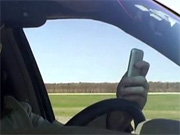
THURSDAY, March 14 (HealthDay News) — Americans are far more likely to use cell phones while driving than Europeans, with one in three U.S. drivers admitting to texting or emailing behind the wheel, U.S. health officials said Thursday.
More than two-thirds of U.S. drivers said they use their phone while driving, compared with 21 percent in the United Kingdom, according to a U.S. Centers for Disease Control and Prevention survey. And nearly one-third of Americans surveyed said they texted or read text messages, twice as many as in Spain.
“We know distracted driving is a serious public health issue,” said report author Rebecca Naumann, a CDC epidemiologist.
“In 2011 alone, we saw that over 3,000 people were killed in crashes that involved distracted driving, and another 300,000 were injured in [such] crashes,” she said.
Drivers should put their cell phone away when they get behind the wheel, Naumann advised. People should drive distraction-free, and parents should be a model of safe driving for teenagers, she added.
CDC Director Dr. Tom Frieden said a cell phone in a car can be a fatal distraction. “Driving and dialing or texting don’t mix. If you are driving, pull over to a safe place and stop before you use your cell phone,” Frieden said in a CDC news release.
The report was published March 14 in the CDC’s Morbidity and Mortality Weekly Report.
For the study, CDC researchers analyzed data on the driving habits of 18- to 64-year-olds in the United States and those of drivers in Belgium, France, Germany, the Netherlands, Portugal, Spain and the United Kingdom.
Far more drivers in the United States said they texted, phoned or read while driving in the previous 30 days compared to motorists in the other countries, the researchers found.
Whereas seven out of 10 U.S. drivers said they talked on their cell phone while driving, only two out of 10 drivers in the United Kingdom said they did so, Naumann said.
“The percentage of drivers who said that they read or sent text or email messages ranged from about 31 percent in the U.S. and Portugal to about 15 percent in Spain,” she said.
Among U.S. drivers, the researchers found a similar number of men and women used cell phones, texted or read while driving. This habit was more common among those aged 18 to 44 than those aged 55 and older.
And Naumann doesn’t think hands-free devices are the solution.
“They cut down on some of the physical and visual distraction, but once a conversation starts there’s still a mental distraction and your mind is taken off the roadway,” she said. “So for hands-free or hand-held, you still have that mental distraction.”
So far, 33 states and the District of Columbia have restrictions on cell phone use by teens and new drivers while driving. But more research is needed to identify other strategies that can prevent cell phone-related collisions, the CDC said.
More information
For more information on distracted driving, visit the U.S. Department of Transportation .

